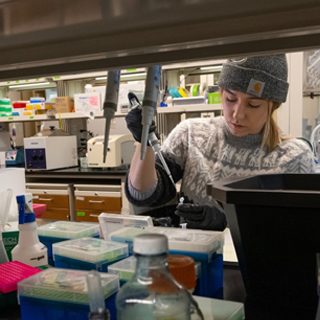EE Program Faculty
Kenneth Dial
Professor Emeritus
Contact
- Office
- HS 416A
- Phone
- (406) 531-3101
- kdial@mso.umt.edu
- Website
- http://cas.umt.edu/dbs/flightlab/default.php
- Curriculum Vitae
- View/Download CV
Personal Summary
Professor Dial is no longer taking on new graduate students
Research Interests:
Evolutionary questions in animal design, transitional stages of locomotor development, allometry of behavior, life history biology and ecology are my primary areas of interest. Moving beyond untestable hypotheses and unfruitful discussions of the origin and evolution of birds is one of my passions at this time. Exploring the mechanistic basis as to why small animals behave and locomote differently than larger species is another area of interest. Apparently an animal’s motor (power-to-mass), rather than the brain’s neural circuitry, has a lot to do with how animals behave.
The Flight Laboratory at the UM Field Station at Fort Missoula enjoys generous space and the equipment necessary to explore how animal’s move. Why are birds the size of swans (e.g., birds about 12 kg) barely able to fly while their smaller relatives enjoy excellent flight performance? What are the morphological and behavioral features during development? How did birds evolve from bipedal dinosaurs? What use is half a wing? Why is a hummingbird bold and curious and an eagle comparatively skittish and weak? How do birds change the shape of their wings and tail during flight? What biomechanical features (muscle and bone mechanics) limit the maximum size of members within a clade and why are most organisms small? These are questions we are currently exploring in our Flight Lab.
Presently my students and I are engaged in an array of investigations that focus on understanding various aspects of animal design. This includes studying how the neuromuscular systems control the wings and the tail during various modes of flight. How birds breathe during flight. The muscle efficiency involved in flight. Using 3-D motion analysis recording systems, high-speed movie film, a wind tunnel and physiological recording equipment (e.g., sonomicrometry, electromyography, bone strain gauges, and pressure transducers) we investigate biological processes at work both inside and outside the animal. Collaborative efforts with colleagues from institutions throughout the United States provide excellent opportunities to learn techniques in high-speed X-ray filming, bone biomechanics, muscle physiology, respiratory physiology and neural physiology. Student projects that couple field observations with measurements fr
Education
B.S. Loyola Marymount University, 1976
M.A. California State University, Long Beach, 1978
Ph.D. Northern Arizona University, 1984
Post-doctoral Fellow, Harvard University 1985-88
Courses Taught
Biology 403: Vertebrate Design and Evolution: Comparative Vertebrate Morphology
Biology 595: Field Biology of East Africa (Field course in Tanzania/Kenya) (graduate)
Biology 595a: Life History, Scaling, and Biogeography (graduate)
Biology 522: Readings in Morphology, Physiology, and Ecology (graduate)
Selected Publications
Heers, A.H., K.P. Dial, and B.W. Tobalske 2014. From baby birds to feathered dinosaurs: incipient wings and the evolution of flight. Paleobiology. 40(3): 459-476.
Dial et al 2014. Great Transformation in Vertebrate Evolution, 2014. Eds. K.P. Dial, N. Shubin, and B. Brainerd. University of Chicago Press
Dial, K.P., A.M. Heers, and T.R. Dial. 2014. Ontogenetic and evolutionary transformations: The ecological significance of rudimentary structures. In: Great Transformations of Vertebrate Evolution. Univ. Chicago Press.
Baier DB, Gatesy SM, Dial KP 2013. Three-Dimensional, High-Resolution Skeletal Kinematics of the Avian Wing and Shoulder during Ascending Flapping Flight and Uphill
Flap-Running. PLoS ONE 8(5): e63982. doi:10.1371/journal.pone.0063982
Dial, K.P., B.E. Jackson, P. Segre. 2008. A fundamental avian wing-stroke provides a new perspective on the evolution of flight. Nature (online 23 Jan 08)
Padian, K. and K. P. Dial. 2005. Could the "Four Winged" Dinosaurs Fly? Nature: 438:E3-5.
Dial, K.P., R. Randall, and T.R. Dial. 2006. What use is half a wing in the evolution of flapping flight? BioScience 56: 437-445.
Tobalske, B.W. and K.P. Dial. 2007. Aerodynamics of wing-assisted incline running. J. Exp. Biol. 210:1742-1751.
Bundle, M.W. and K.P. Dial. 2003. Mechanics of wing-assisted incline running. J. Exp. Biol., 206:4553-4564.
Dial, K.P. 2003. Evolution of avian locomotion: Correlates of body size, reproductive biology, flight style, development and the origin of flapping flight. Auk 120:941-952.
Dial, K.P. 2003. Wing-assisted incline running and the evolution of flight. Science 299:402-404.
Hobbies
Pilot: (1981): ATP (airline transport pilot), multiengine-, instrument-, and commercial- rated, jet pilot and fly about 250 hours per year.
Recreational activities: fly-fishing, flying aircraft, blues/jazz guitar, golf, tennis, down-hill skiing, scuba diving, mountain and road biking

